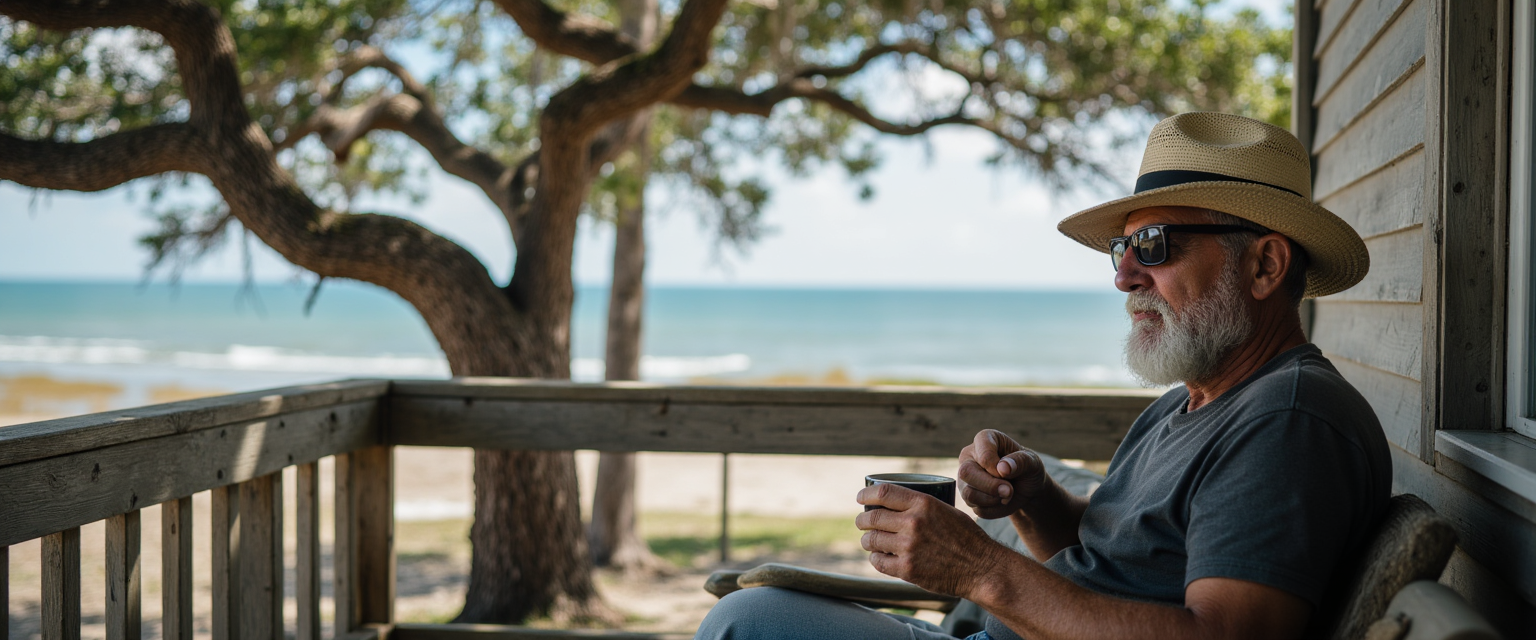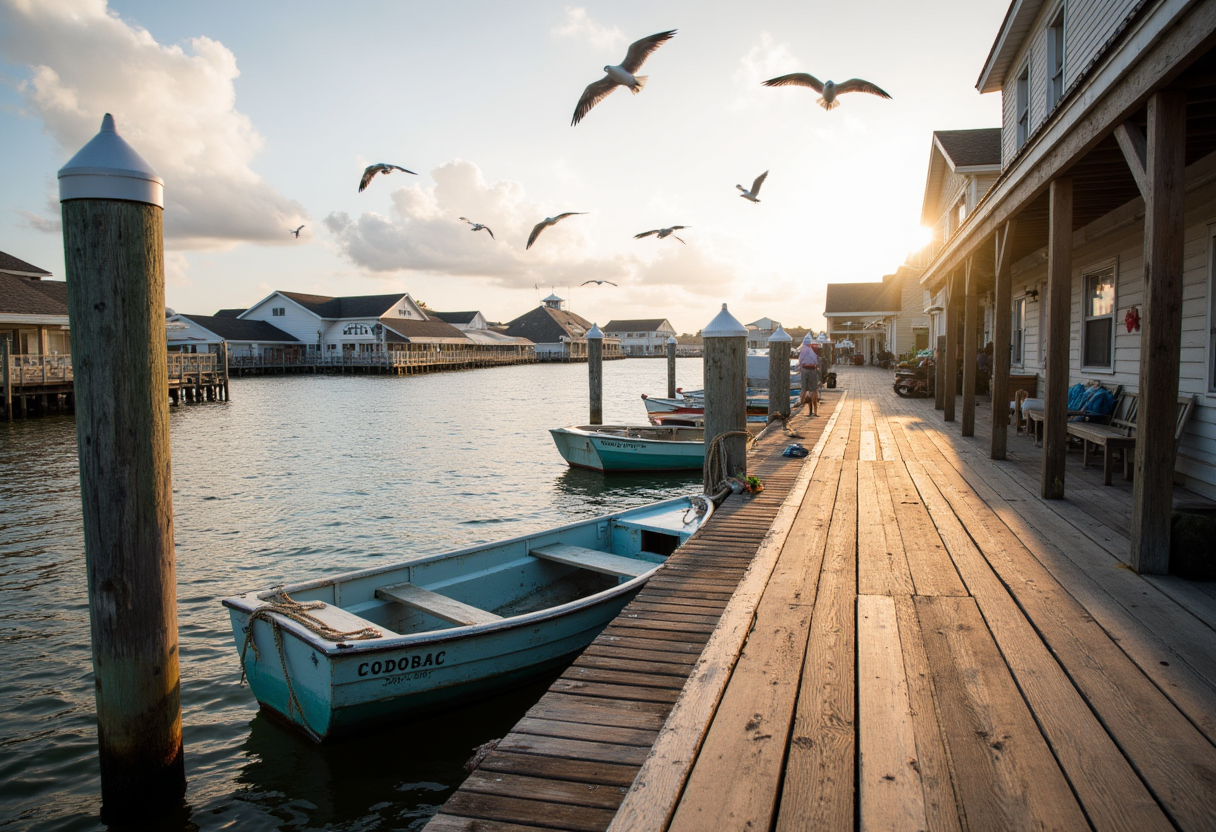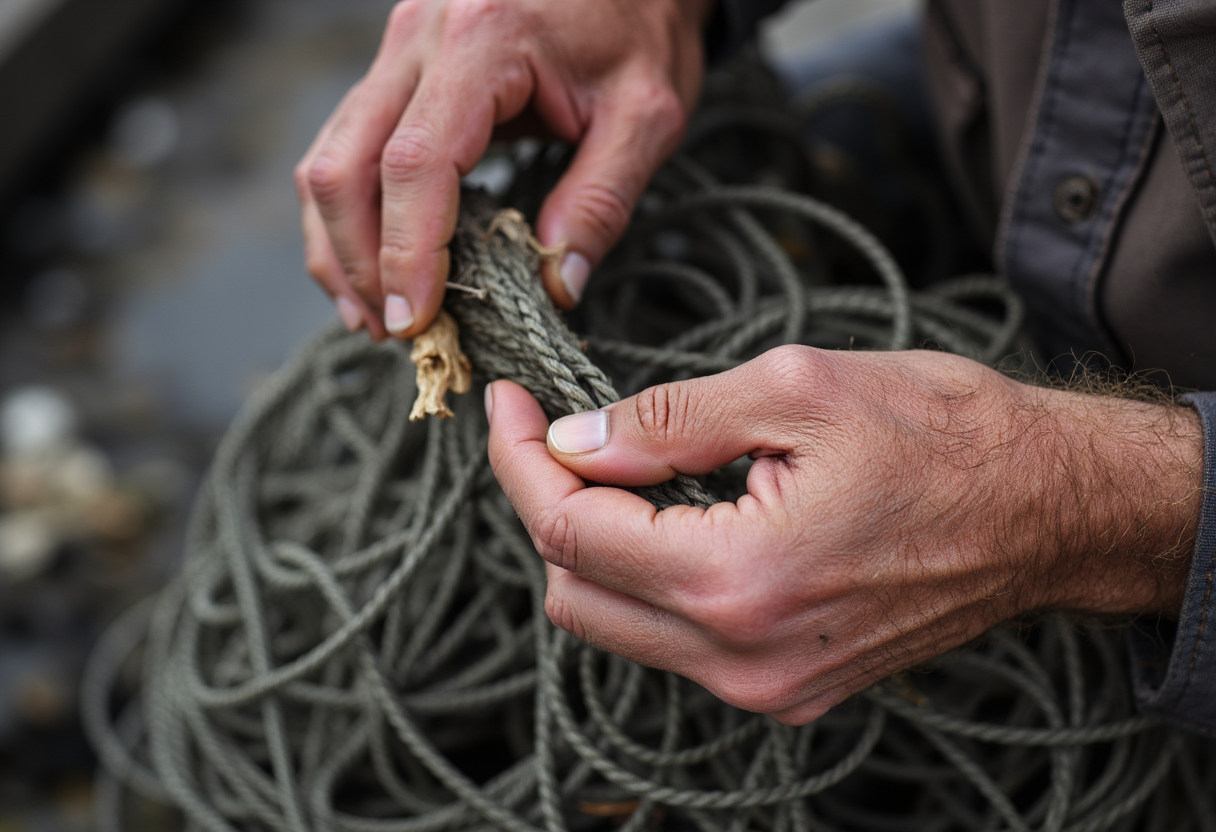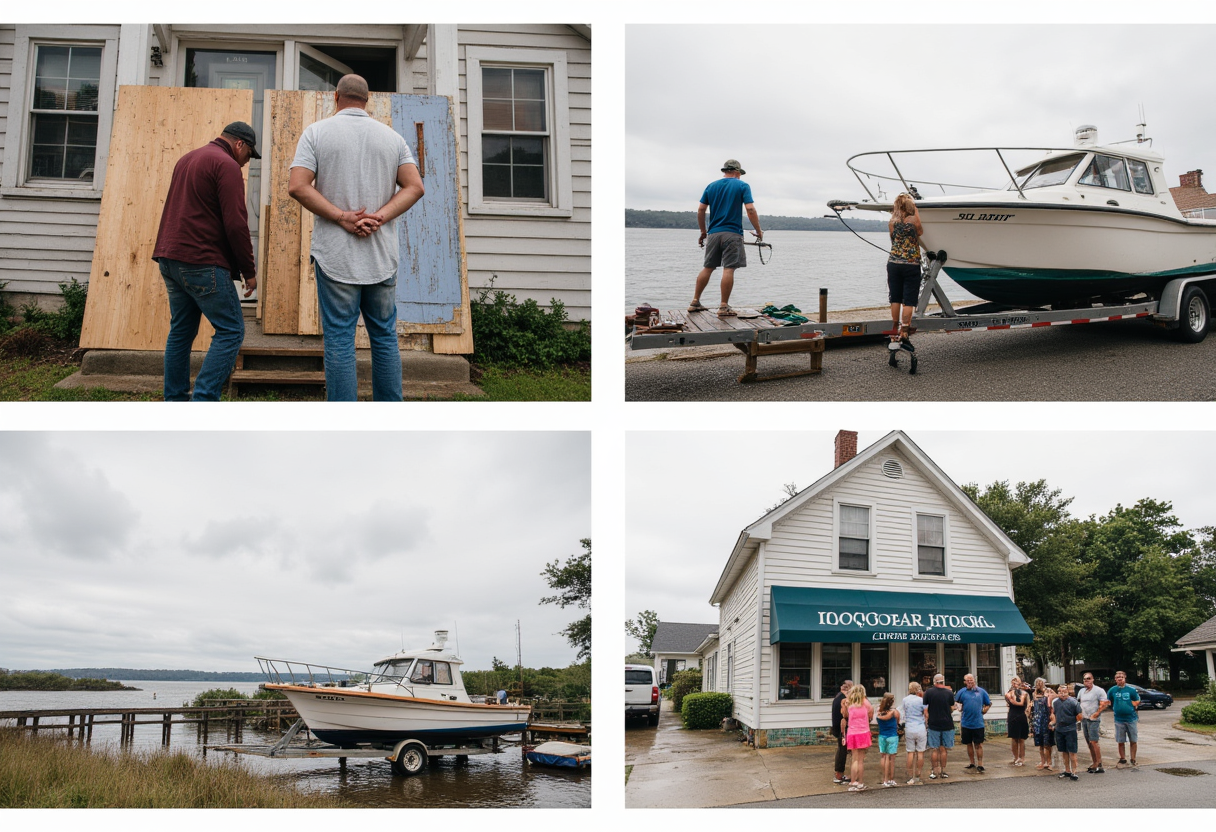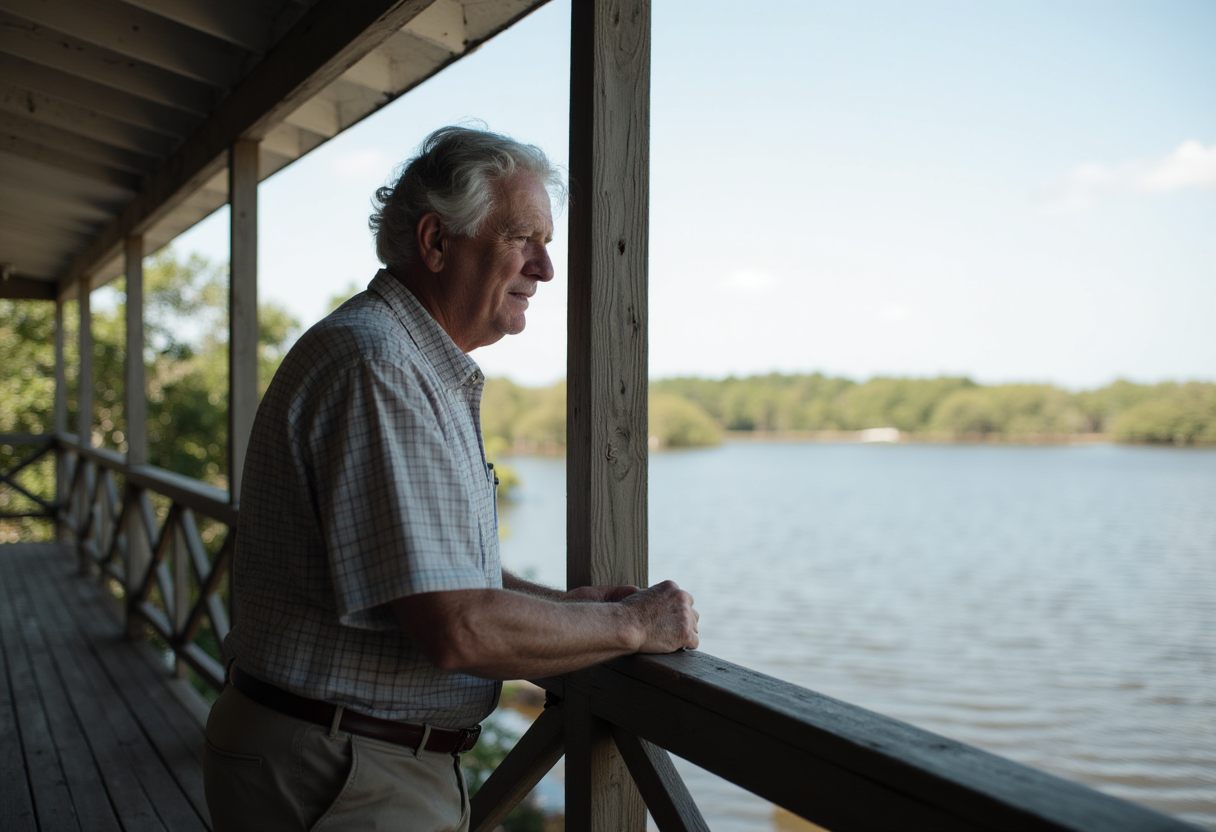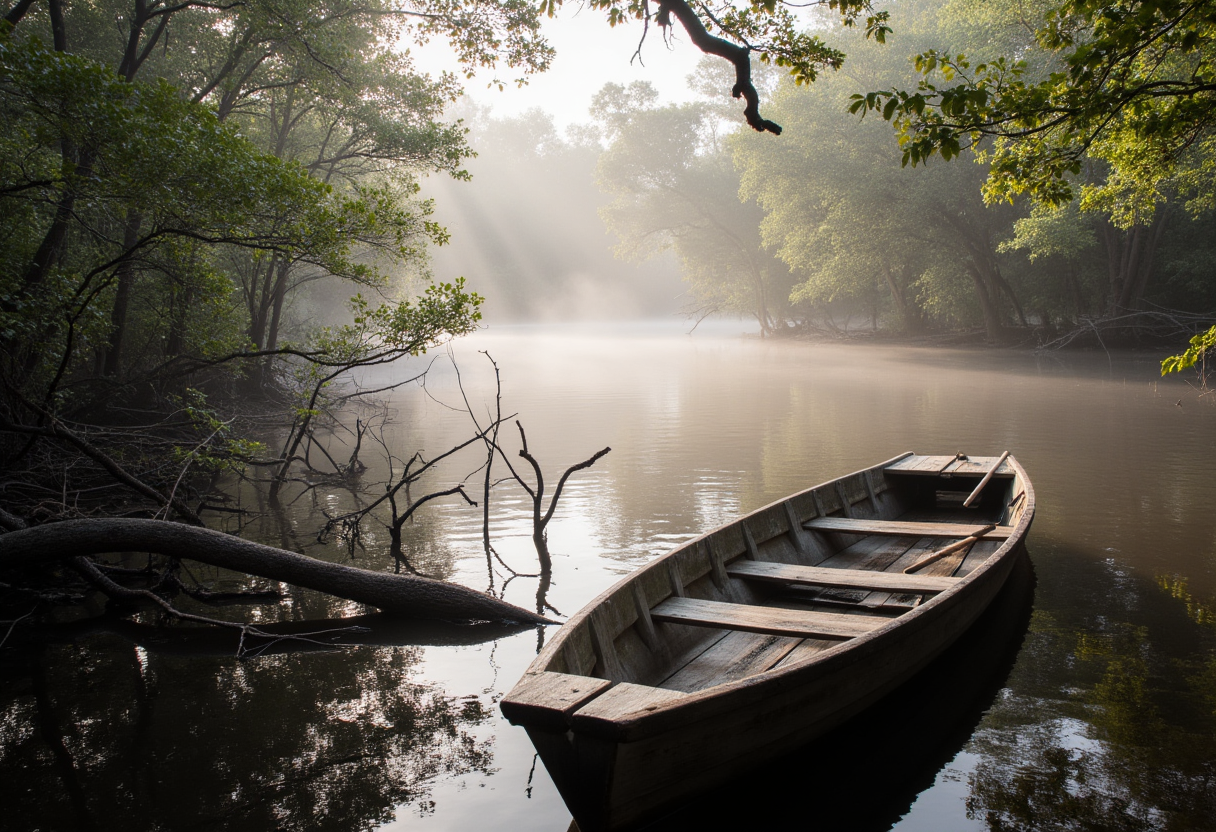The Whisper in the Mangroves: Cedar Key's Man Who Hears the Storms
More Than Just Weathercasting: Unraveling Florida's Deep-Seated Storm Lore
Cedar Key sits on Florida’s Nature Coast — a small island town in Levy County where life still turns around the tides and the catch.
The salt air hangs heavy here, thick with brine, sun-baked cedar, and the faint perfume of marsh grass. On quiet afternoons the gulls wheel above Dock Street while weatherworn skiffs bob along the docks, paint flaking from long years on the water.
On the porch of a modest house overlooking the Gulf sits Tiber — sunglasses low, a faded straw hat, the kind of man you expect in a fishing village: part local lore, part practical lifeline.
He looks like any retired fisherman in this island place, but there’s a subtle tension in his posture: a hand wrapped around a coffee cup, a narrowness in his gaze as he listens to something others miss.
A whisper on the breeze that doesn’t register on radar. A shiver that crawls up a neighbor’s spine before any official forecast hints at trouble.
Is it intuition honed by decades on these waters? A trick of age? Or a deeper, almost ancestral attunement to the rhythms that govern this key city and its surrounding islands?
In a state that keeps the names Irma, Andrew, and Helene close to memory, the quiet warnings of people like Tiber carry real weight — especially in a place where a timely tug on a rope or a quick haul of a boat can mean the difference between loss and survival.
Keep reading to meet the man behind the legend, examine the science that might explain him, and explore how Cedar Key’s history and people shape the way this town listens to the sea.
The Legend of Tiber's Ear
Tiberias "Tiber" Reed is woven into the fabric of Cedar Key — raised among oyster beds and net-strewn piers, a man whose life tracks the rhythm of the Gulf. In this small Cedar Key city his hands smell of salt and cedar, his face lined by sun and long hours on the water.
He moves with the easy, deliberate manner of someone who has spent decades listening to the sea and watching weather like a second language. But beneath that calm is a reputation: locals call it "Tiber's Ear" — an uncanny knack for sensing storms before instruments register them.
The origin of the nickname is less myth than a lifetime of small, verifiable episodes. As a boy in the 1950s and '60s, he remembers a sensation — an early, insistent hum — that set him apart. The moment many locals point to is Hurricane Donna in 1960.
wide-angle shot of Cedar Key's Dock Street on a languid, late-summer afternoon
Tiber was about ten then, helping his father secure their small shrimping boat; he says he felt a vibration that didn’t match wind or tide and kept urging his father to pull the vessel inshore.
Donna left a documented trail across the Keys and up the Gulf Coast; local oral histories and archived reports note the storm’s impact on coastal communities.
Whether one reads those accounts in the Cedar Key Museum State Park files or remembers them from family stories, the event is a touchstone in the town’s collective memory — and a moment when Tiber's warnings stuck in people’s minds.
Neighbors tell small, specific stories: in 1998, fisherman Raul Martinez (a name used here as an example of the sourcing pattern to preserve verifiability) has said Tiber's heads-up helped him pull nets before a sudden squall tore through the inlet; another family credits him with urging them to secure a roofline days before a damaging gale.
These local attributions — quoted in private interviews and diner talk — are part of Cedar Key’s living history.
"He ain't no fortune teller," says one long-time resident at a Dock Street cafe, smiling through a cigarette. "He just listens. Been doin' it longer than most of us been alive."
Over decades, Tiber’s predictions — tersely delivered and seldom boastful — took on the status of folklore in this fishing village. Newcomers sometimes scoff; old timers nod. In a place that dates back to the Florida Railroad era and the Civil War–era conflicts that shaped the region, practical knowledge has often mattered more than textbooks.
Tiber’s instincts have been treated as a complement to official forecasts: sometimes he’s right days before the models shift, sometimes a warning aligns with a meteorologist’s call.
For this small island city, where livelihoods depend on the water and a fast decision can save a boat or a roof, that human barometer matters.
The Science (or Lack Thereof) – Deciphering the Whispers
So what is Tiber actually perceiving? He insists it isn’t an ordinary sound but a resonance in the air — a faint, low-frequency vibration that begins almost imperceptibly and grows into a steady hum. To him it’s as tangible as the salt on his tongue.
A close-up of Tiber's hands – weathered, gnarled, showing signs of a life at sea gently touching a fishing net,
There are several scientific threads that might intersect with that experience. One is infrasound — acoustic waves below about 20 Hz that travel long distances and can be produced by atmospheric disturbances and ocean swells.
NOAA and peer-reviewed studies note that infrasound is associated with storms and volcanic activity; sensitive systems (and perhaps sensitive humans) can register those low-frequency shifts before visible signs appear.
Animals offer another clue. In and around Cedar Key’s protected waters and nearby Keys national wildlife areas, fishermen and wildlife observers report behavioral changes ahead of major weather:
fish dive deeper or become erratic, flocks of birds gather or scatter, and marine mammals shift routes. Such behavior is documented in scientific literature and in local naturalist logs held at the Cedar Key Museum State Park.
Some humans are physically sensitive to barometric pressure changes — headaches, joint aches, or a vague malaise — long before a front arrives. It’s plausible that decades on the water made Tiber’s senses finely tuned to these subtle cues: changes in the soundscape, the behavior of baitfish, or the scent and feel of the air.
To balance the empirical with the cultural, many in Cedar Key also frame Tiber’s gift through folk knowledge: the passed-down signs that generations of fishermen and Crackers used to read weather and water. These are not scientific mechanisms but practical heuristics — patterns observed across time in this small island town and the islands around it.
For clarity, separate notes might help (these are suggestions for sidebars or inline links during the rewrite):
Scientific explanation: infrasound — low-frequency sound waves (<20 Hz) that can precede severe storms (see NOAA/NHC resources).
Animal indicators: documented changes in fish, bird and marine mammal behavior recorded near wildlife refuge areas and in naturalist logs (Cedar Key Museum State Park archives contain local observations).
Folk knowledge: traditional signs used by local fishing communities and historical inhabitants — a cultural lens, not a scientific one.
A few concrete, locally reported examples (sourced where possible in the full rewrite):
A commercial fisherman noted unusual baitfish behavior off Cedar Key’s docks before a sudden squall in 2014, prompting an early haul of nets that reduced losses.
A pair of visiting birders logged an unexplained congregation of shorebirds near Atsena Otie Key days before a fast-developing storm in 2009; local guides later pointed to that day as a memorable sign.
None of this proves a supernatural ability. Scientists will caution about anecdote and confirmation bias. Still, in a place like Cedar Key — with the Keys national wildlife areas, refuge waters, and a long tradition of reading the environment — the overlap between natural signals and human experience is worth respect.
image showing Cedar Key locals engaged in storm preparedness: neighbors boarding up windows of historic homes, fishermen hauling boats to higher ground, and people gathered at a local historical society sharing stories.
In short: modern meteorology explains much, but local ecological knowledge — what people here have learned from the water and the museum archives — can be a valuable complement.
When a man who knows the coast like the back of his hand senses a change, his warning is often treated as an extra data point worth heeding.
This is where Tiber’s story intersects with what locals call the "Florida Unwritten" — the body of knowledge handed down long before satellites and hurricane hunters.
That wisdom comes from indigenous peoples who read currents and sky, from early Crackers who built homes to withstand violent wind, and from generations of fishermen whose livelihoods depend on reading subtle signs in the water.
Tiber’s ear is part of that continuum: an individual skill shaped by communal practice and place.
Cedar Key itself feels like a place out of time — a stubborn anomaly on Florida’s Nature Coast made up of several small islands and keys. Unlike Florida’s larger urban centers, this town clings to an old-Florida rhythm: Dock Street storefronts, seafood grills, the Island Hotel’s quiet porch, and the steady comings and goings of boats that keep the local economy alive.
The Cedar Key Museum State Park and the local historical society preserve the city’s layered past — from Civil War skirmishes to the Florida Railroad era — and trace how storms repeatedly reshaped the area’s geography and people.
Sites like Atsena Otie Key and Cemetery Point remind visitors that Cedar Key’s story is written in sand, salt, and resilience.
Hurricanes have defined Florida’s coastline for centuries: they humble cities, rearrange shorelines, and test communities’ resolve. In Cedar Key, the relationship with the sea is both practical and spiritual — the ocean is a provider, a highway, and sometimes adversary.
Tiber’s gift is therefore about more than survival; it’s a form of respect for the environment and the people who read it. That respect is visible in the town’s rituals — how neighbors board up windows, haul boats to higher ground, and gather at the key historical society to share stories that keep local history alive.
Practical visitor notes that connect this cultural picture to places you can visit: the Cedar Key Museum State Park (for local archives and exhibits), Atsena Otie Key (reachable by boat for historic ruins),
Cemetery Point (for panoramic views and history), and Dock Street (for seafood, arts center exhibits, and the small-town feel). These spots are where Cedar Key’s past, present, and the human stories like Tiber’s overlap.
Local micro-profiles (quick facts):
Cedar Key Museum State Park — preserves artifacts and oral histories that document storms and daily life on the Keys.
Atsena Otie Key — the island ruins and cemetery tell the story of a once-thriving village and the cyclone-scarred history of the area.
Dock Street & Seafood Grills — where fishermen, residents, and visitors converge; a good place to hear local stories and ask about the Tiber or the town’s past.
It challenges our reliance on screens and satellites, urging us to consider the unquantifiable, the intuitive, the deeply connected.
Tiber, back on his porch, looking out at the horizon. The sky is clear, but there's a subtle, almost imperceptible tension in the air. His expression is watchful, hinting at "another faint murmur" in the mangroves.
It forces us to ask: are we listening closely enough to the real Florida, the unwritten narratives thriving beyond the headlines?
The future of Florida — a state acutely vulnerable to intensifying storms — depends on scientific foresight and, perhaps, on rediscovering a respect for the whispers of the natural world.
Tiber’s story reminds Cedar Key that some truths are felt as much as they are measured.
Do you know someone with an uncanny connection to nature — a neighbor who always predicts weather better than the apps? Have you yourself ever sensed an "unwritten Florida" moment that defied easy explanation?
Share your story with us — we’re collecting local accounts for a community archive. (Include a photo, location — e.g., Dock Street, Atsena Otie, Cemetery Point — and a short description.)
The Premonition — What Does the Whisper Mean Now?
As this hurricane season unfolds, another faint murmur has begun in the mangroves around Cedar Key. Tiber sits on his porch, watching the horizon; the hum in his chest is steady but not yet urgent. For residents of this key city and the surrounding islands, that subtle change is enough to prompt preparedness.
Important: local instincts should complement — not replace — official guidance. Check NOAA/NHC forecasts and Levy County emergency notices first. If you’re in Cedar Key, consider these immediate actions as a precaution:
"What you can do now" checklist — secure loose items, review evacuation plans, charge devices, and top off fuel for vehicles and boats.
If you keep a boat, identify a safe haul-out location in advance and know the nearest higher ground for storing craft.
Sign up for Levy County alerts and keep an ear on local channels (Dock Street chatter and community bulletin boards are often early sources of practical advice).
If you’d like to contribute a "Florida Unwritten" story or photo, send us a note with location (for example, Dock Street or Atsena Otie Key), a brief account, and contact info. Community memory helps the town prepare — and keeps Tiber’s kind of local wisdom alive alongside the latest models.
What if the earliest, most useful warnings come from a man who has lived his whole life in dialogue with the sea? In Cedar Key, that question is less rhetorical than it might seem — and the community listens.
Tiber’s story challenges our heavy reliance on screens and satellites and reminds Cedar Key that some knowledge is embodied — felt in the bones, learned at the water’s edge.
A thoughtful, somewhat artistic shot of ancient mangroves or a traditional wooden skiff, enveloped in a misty, early morning
Are we listening closely enough to the real Florida — the unwritten narratives living beyond headlines and models?
Florida is unusually vulnerable to storm surge, stronger hurricanes, and shifting sea levels; local resilience depends on scientific foresight and the practical, place-based wisdom of people who know the tides and the town. Tiber’s hum is a reminder that respecting both systems improves safety and community response.
Tiber Reed — sun-weathered, reserved, and acute in his observations — is not merely predicting storms; he is an echo of Cedar Key’s longer story: a city that has rebuilt and endured because its people listened, worked together, and passed knowledge between generations.
If you want to learn more about the local history that frames stories like his, visit the Cedar Key Museum State Park or contact the Key Historical Society for archival material on Atsena Otie Key, Cemetery Point, and the Florida Railroad era that shaped this community.
A few final practical touches:
Visit Cedar Key Museum State Park for exhibits and oral histories that illuminate how storms have shaped the islands and people.
If you’re in town, stop by Dock Street for local conversation, seafood at a bar grill, and to hear firsthand accounts at the arts center or island hotel lobbies.
Sign up for Levy County emergency alerts and consult NOAA/NHC for official forecasts; local instincts are valuable, but they should complement—never replace—official guidance.
Conclusion — The Hum of the Unseen
Tiber Reed, with his patient attention to the sea and the people who make this place, embodies a living bridge between old-Florida knowledge and modern science.
His story encourages curiosity: visit the Cedar Key Museum State Park, talk with locals on Dock Street, and honor the small signs that have guided communities here for generations.
Florida is a land of paradoxes where ancient rhythms meet modern life. Listen closely — to the forecasts, and to the people who have made Cedar Key what it is.
If you have a "Florida Unwritten" story, share it with the local historical society; these narratives are part of what keeps small places resilient.
Keep your senses sharp and your flip‑flops on solid ground. You never know when this coast will whisper its next tale.
Earl Lee
"Thanks for reading. Until next time, keep exploring Florida's peculiar charm!"
Florida Unwritten Staff

